The Urethane Blog
Everchem Updates
VOLUME XXI
September 14, 2023
Everchem’s exclusive Closers Only Club is reserved for only the highest caliber brass-baller salesmen in the chemical industry. Watch the hype video and be introduced to the top of the league: — read more
March 5, 2021
We’ve had a lot of questions about why there is a shortage of foam, so here’s a simple explanation. I hope it answers your questions!
Flexible Foam Production and Fabrication
Because foam is light and bulky, it is not efficient to ship very far to the various end users such as furniture manufacturers, bedding, seating and other customers. Consequently the many foam plants are located close to the end use markets and are spread around North America.
Foam is made using a number of chemicals, but the main two are polyol and toluene diisocyanate (TDI). It takes roughly two parts of polyol and one part of TDI to make foam. Foam plants buy these raw materials and have them delivered by either railcars or tank trucks. A typical foam plant will have storage tanks that are big enough to offload a few railcars (180,000 lbs each) or tank trucks (45,000 lbs each). They don’t carry a large inventory of these raw materials, but depend upon a steady and timely supply of railcars and trucks in order to produce the foam for their customers.
Polyol Supply
There are a few different grades of flexible foam polyol, but the most common is made from three primary raw materials–glycerine (the initiator), ethylene oxide (EO) and most of all, propylene oxide (PO). PO is by far the main ingredient.
There are a handful of large polyol producers with a few plants in the midwest but most are on the Gulf coast–close to the propylene oxide producers.
The Propylene Oxide Bottleneck
PO is produced by three companies in North America, LyondellBasell, Dow, and Indorama. There are five physical plant locations, with four in Texas and one in Louisiana.
When the pandemic hit last March there was a lot of uncertainty about future demand. The entire furniture-foam-polyol-PO chain of production slowed to a crawl.
No one predicted that the demand for bedding and furniture would increase while people were in lock down. The industry came back in June hoping to catch up for the lost production in that April May time frame. The industry tried to run at 120% rates to make up for the two lost months, but the PO plants can only run at 100%, so there was not enough to supply everyone what they wanted. PO production issues in the Fall curtailed polyol production even further to the point that the producers had to put together allocations for their customers. No one could get everything that they needed.
Then the winter storm hit the gulf coast in mid February. When a hurricane is expected, the petrochemical industry gets prepared and often shuts down their operations in advance, weathers the storm, then gets back up and running safely and in a relatively short time frame. This storm caught everyone unprepared and many plants lost power while they were still running. It’s a tribute to the industry and all the plant engineers and employees that there were no major accidents during this abrupt and unexpected shutdown. Lines in the plants froze. Power, steam, nitrogen, and hydrogen supplies were lost. All of the propylene oxide plants were shut down. It was almost like an unexpected Cat 5 hurricane hit all of Texas in the middle of the night.
Restarting those plants first requires the utilities and power. The damage can’t be assessed until services like steam and nitrogen are restored (and in many cases, they’re still down). Then all the lines need to be inspected and damage repaired. The plants will start at reduced rates and may take months to get back up to full rates. Meanwhile, the entire polyol inventory pipeline is empty and needs to be refilled.
There is still a lot of uncertainty about the timing for the restart of the foam industry. The situation literally changes every day as the companies assess the damage and work on repairs so the units can be restarted safely. We post daily updates here on the Urethane Blog, so check us out regularly for more information.
TDI
The TDI story is similar to propylene oxide except that there are only two domestic producers and two physical plant locations. Supply is supplemented by some imports. Those plants are located in Texas and Louisiana and were also affected by the winter storm.
Now you know why the wait time for a new chair is at least 16 weeks and may get even longer!
March 5, 2021
We’ve had a lot of questions about why there is a shortage of foam, so here’s a simple explanation. I hope it answers your questions!
Flexible Foam Production and Fabrication
Because foam is light and bulky, it is not efficient to ship very far to the various end users such as furniture manufacturers, bedding, seating and other customers. Consequently the many foam plants are located close to the end use markets and are spread around North America.
Foam is made using a number of chemicals, but the main two are polyol and toluene diisocyanate (TDI). It takes roughly two parts of polyol and one part of TDI to make foam. Foam plants buy these raw materials and have them delivered by either railcars or tank trucks. A typical foam plant will have storage tanks that are big enough to offload a few railcars (180,000 lbs each) or tank trucks (45,000 lbs each). They don’t carry a large inventory of these raw materials, but depend upon a steady and timely supply of railcars and trucks in order to produce the foam for their customers.
Polyol Supply
There are a few different grades of flexible foam polyol, but the most common is made from three primary raw materials–glycerine (the initiator), ethylene oxide (EO) and most of all, propylene oxide (PO). PO is by far the main ingredient.
There are a handful of large polyol producers with a few plants in the midwest but most are on the Gulf coast–close to the propylene oxide producers.
The Propylene Oxide Bottleneck
PO is produced by three companies in North America, LyondellBasell, Dow, and Indorama. There are five physical plant locations, with four in Texas and one in Louisiana.
When the pandemic hit last March there was a lot of uncertainty about future demand. The entire furniture-foam-polyol-PO chain of production slowed to a crawl.
No one predicted that the demand for bedding and furniture would increase while people were in lock down. The industry came back in June hoping to catch up for the lost production in that April May time frame. The industry tried to run at 120% rates to make up for the two lost months, but the PO plants can only run at 100%, so there was not enough to supply everyone what they wanted. PO production issues in the Fall curtailed polyol production even further to the point that the producers had to put together allocations for their customers. No one could get everything that they needed.
Then the winter storm hit the gulf coast in mid February. When a hurricane is expected, the petrochemical industry gets prepared and often shuts down their operations in advance, weathers the storm, then gets back up and running safely and in a relatively short time frame. This storm caught everyone unprepared and many plants lost power while they were still running. It’s a tribute to the industry and all the plant engineers and employees that there were no major accidents during this abrupt and unexpected shutdown. Lines in the plants froze. Power, steam, nitrogen, and hydrogen supplies were lost. All of the propylene oxide plants were shut down. It was almost like an unexpected Cat 5 hurricane hit all of Texas in the middle of the night.
Restarting those plants first requires the utilities and power. The damage can’t be assessed until services like steam and nitrogen are restored (and in many cases, they’re still down). Then all the lines need to be inspected and damage repaired. The plants will start at reduced rates and may take months to get back up to full rates. Meanwhile, the entire polyol inventory pipeline is empty and needs to be refilled.
There is still a lot of uncertainty about the timing for the restart of the foam industry. The situation literally changes every day as the companies assess the damage and work on repairs so the units can be restarted safely. We post daily updates here on the Urethane Blog, so check us out regularly for more information.
TDI
The TDI story is similar to propylene oxide except that there are only two domestic producers and two physical plant locations. Supply is supplemented by some imports. Those plants are located in Texas and Louisiana and were also affected by the winter storm.
Now you know why the wait time for a new chair is at least 16 weeks and may get even longer!
March 5, 2021
MEGlobal restarts Texas MEG unit; TPC expects longer restart timeline
- Author
- Kristen Hays
- Editor
- Kshitiz Goliya
- Commodity
- Petrochemicals
Houston —
Efforts to restart petrochemical plants along the US Gulf Coast that shut down amid sustained sub-freezing temperatures in mid-February continued March 4, with downstream derivatives awaiting resumption of production of upstream feedstocks.
MEGlobal has restarted its 750,000 mt/year monoethylene glycol unit in Freeport, Texas, but more than 3 million mt/year of US MEG capacity remained shut, multiple market sources said March 4.
TPC Group expects to restart production units at its Houston petrochemical site the week of March 14, pending restarts of utilities and additional inspections slated for the week of March 8, spokeswoman Sara Cronin said in an email late March 3.
TPC had expected to restart utilities at the Houston site the week of Feb. 28, but found additional freeze-related issues that delayed that initial timeline, she said.
The freeze that affected much of the country reached the US Gulf Coast on Feb. 14, bringing bitter cold temperatures that lasted for more than 72 hours. The freeze prompted petrochemical shutdowns throughout Texas and in parts of Louisiana. The industrial infrastructure in the region was not built to withstand such sustained sub-freezing temperatures, and inspections have been deliberate to seek out any problems with exposed pipes that must be repaired.
“You need to go slow, to make sure there is no leakage on places which cannot be examined visually,” a market source said.
Here is a rundown of the fallout from the freeze:
FORCE MAJEURES
**Dow Chemical: Declared Feb. 19, on 2-ethylhexanol and butanol products from its Texas City, Texas complex
**Formosa Plastics USA: Declared Feb. 19 on US polyethylene
**BASF: Declared Feb. 19 on dioctyl terephthalate, or DOTP, a plasticizer, at its Pasadena, Texas, site
**Westlake Chemical: Declared Feb. 19 on US caustic soda, chlorine, PVC and vinyl chloride monomer (VCM); company has 2.9 million mt/year of US caustic soda capacity, more than 2 million mt/year of PVC capacity, 2.6 million mt/year of VCM; more than 2.26 million mt/year of chlorine capacity at five affected sites
**Formosa Plastics USA: Declared Feb. 18 on US PVC, 1.3 million mt/year of capacity at Point Comfort, Texas, and Baton Rouge, Louisiana, complexes.
**Dow Chemical: Declared Feb. 18 on multiple intermediate chemicals produced at plants in Deer Park, Freeport, Texas City and Bayport Texas, Hahnville, Louisiana, and Louisville, Kentucky; declaration includes VAM, methyl methacrylate (MMA), glacial methacrylic acid (GMAA), butyl methacrylate (BMA), glycidyl methacrylate (GMA), 2-ethylhexyl Acrylate (2EHA), butyl acrylate (BA), and others; Dow informed South American customers
**Celanese: Declared force majeure Feb. 18 on multiple intermediate chemicals normally sold to customers in the US, Europe and the Middle East, including acetic acid, VAM, ethyl acetate and ethylene vinyl acetate (EVA)
**Total: Declared Feb. 17 on polypropylene produced at its 1.15 million mt/year La Porte, Texas, facility
**Formosa Plastics USA: Declared Feb. 17 on all chlor-alkali products
**LyondellBasell: Declared Feb. 16 on styrene monomer
**Vestolit: Declared Feb. 16 on PVC produced at its Colombia and Mexico plants on lack of upstream vinyl chloride monomer feedstock from US suppliers; plants have a combined 1.8 million mt/year of capacity
**Olin: Declared Feb. 16 on US chlorine, caustic soda, ethylene dichloride, epoxy, hydrochloric acid and other products produced at its Freeport, Texas, complex; on Feb. 18 Olin expanded the declaration in a separate letter to customers to include products made system-wide
**MEGlobal: Declared Feb. 15 on MEG produced at its Freeport, Texas, site
**LyondellBasell: Declared Feb. 15 on US polyethylene
**Flint Hills Resources: Declared Feb. 15 on polypropylene produced at Longview, Texas
**OxyChem: Declared Feb. 15 on US chlorine, caustic soda, EDC, VCM and PVC.
**LyondellBasell: Declared Feb. 15 on US polypropylene
**INEOS Olefins and Polymers USA: Declared Feb. 15 on polypropylene
**OQ Chemicals: Declared Feb. 15 on US oxo-alcohols, aldehydes, acids and esters produced at its Bat City, Texas, operations
SHUTDOWNS
**Chevron Phillips Chemical: three crackers with a combined capacity of 1.36 million mt/year, Sweeny, Texas
**Westlake Chemical: 331,763 mt/year cracker, 249,475 mt/year chlorine, 274,423 mt/year caustic soda, 680,388 mt/year VCM, 680,388 mt/year PVC, Calvert City, Kentucky
**Eastman Chemical: 730,000 mt/year ethylene capacity, Longview, Texas
**INEOS: 1.89 million mt/year of ethylene capacity, Chocolate Bayou, Texas
**LyondellBasell: 2.29 million mt/year of ethylene capacity in La Porte and Corpus Christi, Texas
**Total: 1.15 million mt/year PP, La Porte, Texas
**Lotte Chemical: 700,000 mt/year MEG, 1 million mt/year joint-venture cracker, Lake Charles, Louisiana
**Braskem: 225,000 mt/year PP, Seadrift, Texas
**ExxonMobil: Cumulative 1.53 million mt/year from three units, HDPE and LLDPE capacity, Mont Belvieu, Texas
**Indorama Ventures: 1 million mt/year ethylene oxide/MEG unit, 238,135 mt/year propylene oxide unit, and 988,000 mt/year of MTBE capacity; Clear Lake, Texas, 435,000 mt/year EO, 358,000 mt/year MEG; Port Neches, Texas
**Olin: Freeport, Texas complex, with 3 million mt/year of caustic soda and 2.73 million mt/year of chlorine capacity; 748,000 mt/year of EDC
**OxyChem: Ingleside, Texas, 544,000 mt/year cracker; 248,000 mt/year chlor-alkali; 680,000 mt/year EDC; Deer Park and Pasadena, Texas, 1.27 million mt in PVC capacity; 1.79 million mt/year of VCM capacity; 580,000 mt/year chlor-alkali
**Shintech: Freeport, Texas: 1.45 million mt/year PVC
**Formosa Plastics USA: Point Comfort, Texas, including three crackers with a cumulative capacity of 2.76 million mt/year; 875,000 mt/year of high density polyethylene; 400,000 mt/year of low density PE; 465,000 mt/year of linear low density PE; 798,000 mt/year of PVC; 1 million mt/year of caustic soda and 910,000 mt/year of chlorine; 753,000 mt/year of VCM; 1.478 million mt/year of EDC; and a cumulative 1.17 million mt/year of MEG operated by sister company Nan Ya Plastics.
**Dow Chemical: Certain units offline within Dow sites along the US Gulf Coast, but the company did not specify. Dow’s Gulf Coast operations include two LDPE units with 552,000 mt/year and 186,000 mt/year HDPE; Dow’s Seadrift, Texas, complex includes 490,000 mt/year LLDPE and 390,000 mt/year HDPE; Dow told South American customers in a letter dated Feb. 16 that the company was assessing impact on PE production capacity “and we know that our ability to supply various products could be affected.”
**Dow Chemical: 998,000 mt/year cracker, Freeport, Texas
**TPC Group: Houston site, including 544,310 mt/year butadiene unit, when boilers lost steam
**CP Chem: Pasadena, Texas, 998,000 mt/year HDPE
**CP Chem: 853,000 mt/year cracker, Port Arthur, Texas
**Westlake Chemical: 632,000 mt/year cracker, Lake Charles, Louisiana
RESTARTS
**MEGlobal: 750,000 mt/year MEG plant, Freeport, Texas
**Formosa Plastics USA: restarting PP production at Point Comfort, Texas, complex; has two PP units with combined capacity of 1.7 million mt/year
**Shell: Restarting two crackers with a combined 961,000 mt/year of capacity, Deer Park, Texas
**OxyChem/Orbia: Restarting 550,000 mt/year cracker, Ingleside, Texas
**LyondellBasell: Restarting two crackers with a combined 1.93 million mt/year of capacity, Channelview, Texas
**CP Chem: Restarting two crackers with a combined 1.9 million mt/year of capacity, Cedar Bayou, Texas
**CP Chem: Restarting 853,000 mt/year cracker, Port Arthur, Texas
**Indorama Ventures: Restarting 235,867 mt/year cracker, Port Neches, Texas
**Dow Chemical: Restarting 680,000 mt/year cracker, Freeport, Texas
**Braskem: 360,000 mt/year PP Freeport, Texas; 400,000 mt/year PP, La Porte, Texas
**Motiva Chemicals: Restarted 635,000 mt/year mixed-feed cracker, Port Arthur, Texas
**Shell: Norco, Louisiana, restarted two crackers with a combined 1.4 million mt/year of capacity
**Baystar Polymers: Restarting 408,000 mt/year HDPE unit at Bayport, Texas
**Flint Hills Resources: Restarting 658,000 mt/year PDH unit, Houston
**Dow Chemical: Restarting 750,000 PDH, Freeport, Texas
**Braskem: Restarting 450,000 mt/year PP, La Porte, Texas
**Dow Chemical: Restarted 680,000 mt/year cracker in Orange, Texas
**ExxonMobil: Beaumont, Texas, restart activity begun; 826,000 mt/year cracker operational; 225,000 mt/year HDPE; 240,000 mt/year LDPE; 1.19 million mt/year LLDPE with some HDPE capacity
**ExxonMobil: Baytown, Texas, restart activity begun; three crackers with a combined capacity of 3.8 million mt/year; 800,000 mt/year PP
**Sasol: Restarted 380,000 mt/year EO/MEG, Lake Charles, Louisiana
**Formosa Plastics USA: Restarted 513,000 mt/year PVC, 653,000 mt/year VCM, Baton Rouge, Louisiana
**LyondellBasell: Lake Charles, Louisiana, joint-venture 470,000 mt/year LLDPE; 420,000 mt/year LDPE
PRICES
**March and April US spot ethylene prices held for a third consecutive day at 57 cents/lb FD Mont Belvieu and 52.75 cents/lb FD Mont Belvieu, respectively, as producers continued working to restart crackers. However, March and April FD Choctaw markers each rose a 1 cent/lb on the day to 57.50 cents/lb and 53.25 cents/lb, respectively.
**March spot propylene prices extended declines on the day March 4, falling 11 cents/lb to 55.25 cents/lb FD USG, while April propylene fell 10 cents/lb to 49.50 cents/lb FD USG after two of the three US PDH plants restarted post-freeze.
— Kristen Hays, kristen.hays@spglobal.com
https://www.spglobal.com/platts/en/products-services/electric-power/gas-and-power
March 5, 2021
MEGlobal restarts Texas MEG unit; TPC expects longer restart timeline
- Author
- Kristen Hays
- Editor
- Kshitiz Goliya
- Commodity
- Petrochemicals
Houston —
Efforts to restart petrochemical plants along the US Gulf Coast that shut down amid sustained sub-freezing temperatures in mid-February continued March 4, with downstream derivatives awaiting resumption of production of upstream feedstocks.
MEGlobal has restarted its 750,000 mt/year monoethylene glycol unit in Freeport, Texas, but more than 3 million mt/year of US MEG capacity remained shut, multiple market sources said March 4.
TPC Group expects to restart production units at its Houston petrochemical site the week of March 14, pending restarts of utilities and additional inspections slated for the week of March 8, spokeswoman Sara Cronin said in an email late March 3.
TPC had expected to restart utilities at the Houston site the week of Feb. 28, but found additional freeze-related issues that delayed that initial timeline, she said.
The freeze that affected much of the country reached the US Gulf Coast on Feb. 14, bringing bitter cold temperatures that lasted for more than 72 hours. The freeze prompted petrochemical shutdowns throughout Texas and in parts of Louisiana. The industrial infrastructure in the region was not built to withstand such sustained sub-freezing temperatures, and inspections have been deliberate to seek out any problems with exposed pipes that must be repaired.
“You need to go slow, to make sure there is no leakage on places which cannot be examined visually,” a market source said.
Here is a rundown of the fallout from the freeze:
FORCE MAJEURES
**Dow Chemical: Declared Feb. 19, on 2-ethylhexanol and butanol products from its Texas City, Texas complex
**Formosa Plastics USA: Declared Feb. 19 on US polyethylene
**BASF: Declared Feb. 19 on dioctyl terephthalate, or DOTP, a plasticizer, at its Pasadena, Texas, site
**Westlake Chemical: Declared Feb. 19 on US caustic soda, chlorine, PVC and vinyl chloride monomer (VCM); company has 2.9 million mt/year of US caustic soda capacity, more than 2 million mt/year of PVC capacity, 2.6 million mt/year of VCM; more than 2.26 million mt/year of chlorine capacity at five affected sites
**Formosa Plastics USA: Declared Feb. 18 on US PVC, 1.3 million mt/year of capacity at Point Comfort, Texas, and Baton Rouge, Louisiana, complexes.
**Dow Chemical: Declared Feb. 18 on multiple intermediate chemicals produced at plants in Deer Park, Freeport, Texas City and Bayport Texas, Hahnville, Louisiana, and Louisville, Kentucky; declaration includes VAM, methyl methacrylate (MMA), glacial methacrylic acid (GMAA), butyl methacrylate (BMA), glycidyl methacrylate (GMA), 2-ethylhexyl Acrylate (2EHA), butyl acrylate (BA), and others; Dow informed South American customers
**Celanese: Declared force majeure Feb. 18 on multiple intermediate chemicals normally sold to customers in the US, Europe and the Middle East, including acetic acid, VAM, ethyl acetate and ethylene vinyl acetate (EVA)
**Total: Declared Feb. 17 on polypropylene produced at its 1.15 million mt/year La Porte, Texas, facility
**Formosa Plastics USA: Declared Feb. 17 on all chlor-alkali products
**LyondellBasell: Declared Feb. 16 on styrene monomer
**Vestolit: Declared Feb. 16 on PVC produced at its Colombia and Mexico plants on lack of upstream vinyl chloride monomer feedstock from US suppliers; plants have a combined 1.8 million mt/year of capacity
**Olin: Declared Feb. 16 on US chlorine, caustic soda, ethylene dichloride, epoxy, hydrochloric acid and other products produced at its Freeport, Texas, complex; on Feb. 18 Olin expanded the declaration in a separate letter to customers to include products made system-wide
**MEGlobal: Declared Feb. 15 on MEG produced at its Freeport, Texas, site
**LyondellBasell: Declared Feb. 15 on US polyethylene
**Flint Hills Resources: Declared Feb. 15 on polypropylene produced at Longview, Texas
**OxyChem: Declared Feb. 15 on US chlorine, caustic soda, EDC, VCM and PVC.
**LyondellBasell: Declared Feb. 15 on US polypropylene
**INEOS Olefins and Polymers USA: Declared Feb. 15 on polypropylene
**OQ Chemicals: Declared Feb. 15 on US oxo-alcohols, aldehydes, acids and esters produced at its Bat City, Texas, operations
SHUTDOWNS
**Chevron Phillips Chemical: three crackers with a combined capacity of 1.36 million mt/year, Sweeny, Texas
**Westlake Chemical: 331,763 mt/year cracker, 249,475 mt/year chlorine, 274,423 mt/year caustic soda, 680,388 mt/year VCM, 680,388 mt/year PVC, Calvert City, Kentucky
**Eastman Chemical: 730,000 mt/year ethylene capacity, Longview, Texas
**INEOS: 1.89 million mt/year of ethylene capacity, Chocolate Bayou, Texas
**LyondellBasell: 2.29 million mt/year of ethylene capacity in La Porte and Corpus Christi, Texas
**Total: 1.15 million mt/year PP, La Porte, Texas
**Lotte Chemical: 700,000 mt/year MEG, 1 million mt/year joint-venture cracker, Lake Charles, Louisiana
**Braskem: 225,000 mt/year PP, Seadrift, Texas
**ExxonMobil: Cumulative 1.53 million mt/year from three units, HDPE and LLDPE capacity, Mont Belvieu, Texas
**Indorama Ventures: 1 million mt/year ethylene oxide/MEG unit, 238,135 mt/year propylene oxide unit, and 988,000 mt/year of MTBE capacity; Clear Lake, Texas, 435,000 mt/year EO, 358,000 mt/year MEG; Port Neches, Texas
**Olin: Freeport, Texas complex, with 3 million mt/year of caustic soda and 2.73 million mt/year of chlorine capacity; 748,000 mt/year of EDC
**OxyChem: Ingleside, Texas, 544,000 mt/year cracker; 248,000 mt/year chlor-alkali; 680,000 mt/year EDC; Deer Park and Pasadena, Texas, 1.27 million mt in PVC capacity; 1.79 million mt/year of VCM capacity; 580,000 mt/year chlor-alkali
**Shintech: Freeport, Texas: 1.45 million mt/year PVC
**Formosa Plastics USA: Point Comfort, Texas, including three crackers with a cumulative capacity of 2.76 million mt/year; 875,000 mt/year of high density polyethylene; 400,000 mt/year of low density PE; 465,000 mt/year of linear low density PE; 798,000 mt/year of PVC; 1 million mt/year of caustic soda and 910,000 mt/year of chlorine; 753,000 mt/year of VCM; 1.478 million mt/year of EDC; and a cumulative 1.17 million mt/year of MEG operated by sister company Nan Ya Plastics.
**Dow Chemical: Certain units offline within Dow sites along the US Gulf Coast, but the company did not specify. Dow’s Gulf Coast operations include two LDPE units with 552,000 mt/year and 186,000 mt/year HDPE; Dow’s Seadrift, Texas, complex includes 490,000 mt/year LLDPE and 390,000 mt/year HDPE; Dow told South American customers in a letter dated Feb. 16 that the company was assessing impact on PE production capacity “and we know that our ability to supply various products could be affected.”
**Dow Chemical: 998,000 mt/year cracker, Freeport, Texas
**TPC Group: Houston site, including 544,310 mt/year butadiene unit, when boilers lost steam
**CP Chem: Pasadena, Texas, 998,000 mt/year HDPE
**CP Chem: 853,000 mt/year cracker, Port Arthur, Texas
**Westlake Chemical: 632,000 mt/year cracker, Lake Charles, Louisiana
RESTARTS
**MEGlobal: 750,000 mt/year MEG plant, Freeport, Texas
**Formosa Plastics USA: restarting PP production at Point Comfort, Texas, complex; has two PP units with combined capacity of 1.7 million mt/year
**Shell: Restarting two crackers with a combined 961,000 mt/year of capacity, Deer Park, Texas
**OxyChem/Orbia: Restarting 550,000 mt/year cracker, Ingleside, Texas
**LyondellBasell: Restarting two crackers with a combined 1.93 million mt/year of capacity, Channelview, Texas
**CP Chem: Restarting two crackers with a combined 1.9 million mt/year of capacity, Cedar Bayou, Texas
**CP Chem: Restarting 853,000 mt/year cracker, Port Arthur, Texas
**Indorama Ventures: Restarting 235,867 mt/year cracker, Port Neches, Texas
**Dow Chemical: Restarting 680,000 mt/year cracker, Freeport, Texas
**Braskem: 360,000 mt/year PP Freeport, Texas; 400,000 mt/year PP, La Porte, Texas
**Motiva Chemicals: Restarted 635,000 mt/year mixed-feed cracker, Port Arthur, Texas
**Shell: Norco, Louisiana, restarted two crackers with a combined 1.4 million mt/year of capacity
**Baystar Polymers: Restarting 408,000 mt/year HDPE unit at Bayport, Texas
**Flint Hills Resources: Restarting 658,000 mt/year PDH unit, Houston
**Dow Chemical: Restarting 750,000 PDH, Freeport, Texas
**Braskem: Restarting 450,000 mt/year PP, La Porte, Texas
**Dow Chemical: Restarted 680,000 mt/year cracker in Orange, Texas
**ExxonMobil: Beaumont, Texas, restart activity begun; 826,000 mt/year cracker operational; 225,000 mt/year HDPE; 240,000 mt/year LDPE; 1.19 million mt/year LLDPE with some HDPE capacity
**ExxonMobil: Baytown, Texas, restart activity begun; three crackers with a combined capacity of 3.8 million mt/year; 800,000 mt/year PP
**Sasol: Restarted 380,000 mt/year EO/MEG, Lake Charles, Louisiana
**Formosa Plastics USA: Restarted 513,000 mt/year PVC, 653,000 mt/year VCM, Baton Rouge, Louisiana
**LyondellBasell: Lake Charles, Louisiana, joint-venture 470,000 mt/year LLDPE; 420,000 mt/year LDPE
PRICES
**March and April US spot ethylene prices held for a third consecutive day at 57 cents/lb FD Mont Belvieu and 52.75 cents/lb FD Mont Belvieu, respectively, as producers continued working to restart crackers. However, March and April FD Choctaw markers each rose a 1 cent/lb on the day to 57.50 cents/lb and 53.25 cents/lb, respectively.
**March spot propylene prices extended declines on the day March 4, falling 11 cents/lb to 55.25 cents/lb FD USG, while April propylene fell 10 cents/lb to 49.50 cents/lb FD USG after two of the three US PDH plants restarted post-freeze.
— Kristen Hays, kristen.hays@spglobal.com
https://www.spglobal.com/platts/en/products-services/electric-power/gas-and-power
March 5, 2021
Stunning Views Of Freight Train Derailment In California Desert
by Tyler DurdenThursday, Mar 04, 2021 – 20:00
On Wednesday evening, a freight train derailment in the Southern California desert sent more than 40 railcars careening off the tracks into a mangled mess of metal.
San Bernardino County Fire (SBCF) tweeted pictures and a drone video of the train derailment. They said the incident occurred on the Burlington Northern Santa Fe Railway Company (BNSF Railway) rail network east of Ludlow, on Old National Trails Highway, or about 150 miles northeast of Los Angeles.
SBCF said, “BNSF cargo railcars, no injuries, no fire, Haz-Mat on scene. No impact to I-40.” Judging by the pictures released by the local police agency, a variety of cars were involved in the incident, including tanker cars, boxcars, and hoppers.
Mixed Freight Derailment
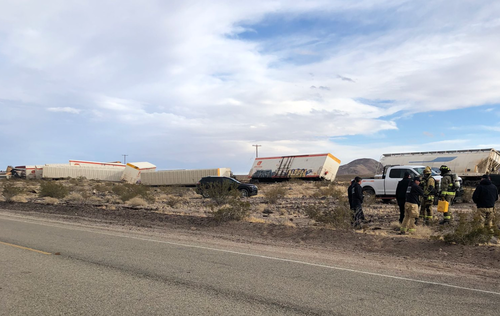
Tanker Cars And Other Cars Derailed
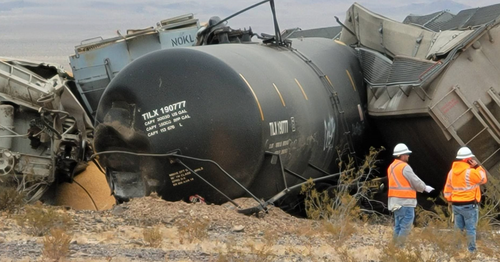
More Scenes Of The Incident
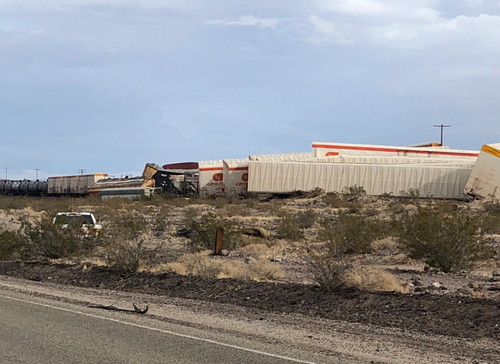
A drone video shows first responders in hazmat suits inspecting a tanker car.
The police drone captured stunning views of the mangled railcars.
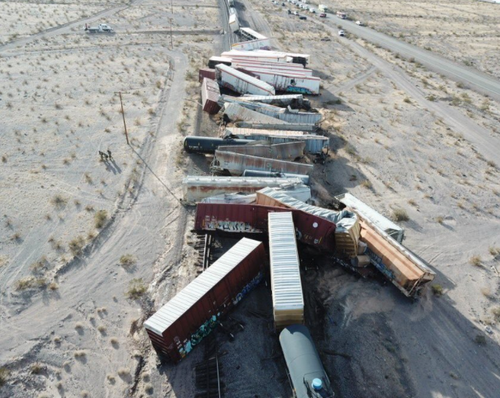
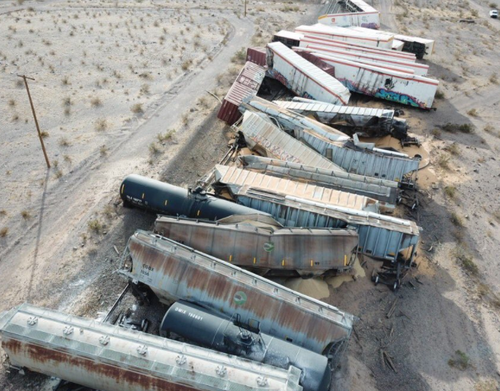
“Initial reports indicate 44 cars derailed, and one car carrying ethanol alcohol is leaking,” BNSF spokeswoman Lena Kent told NBC Los Angeles.
Investigators are still working the incident area to figure out how the derailment occurred.
